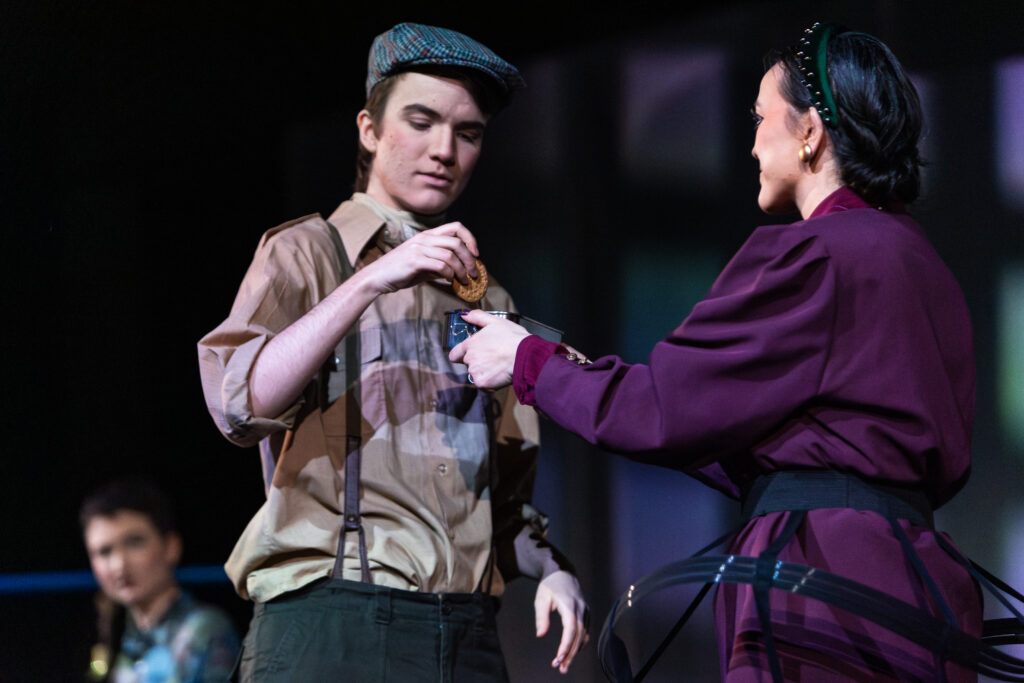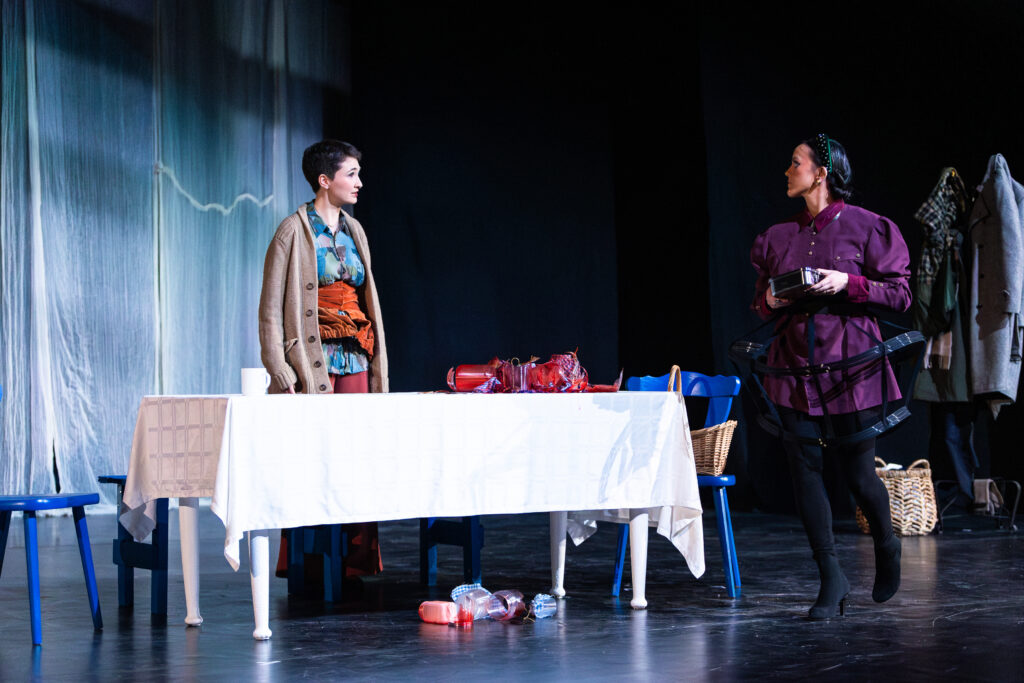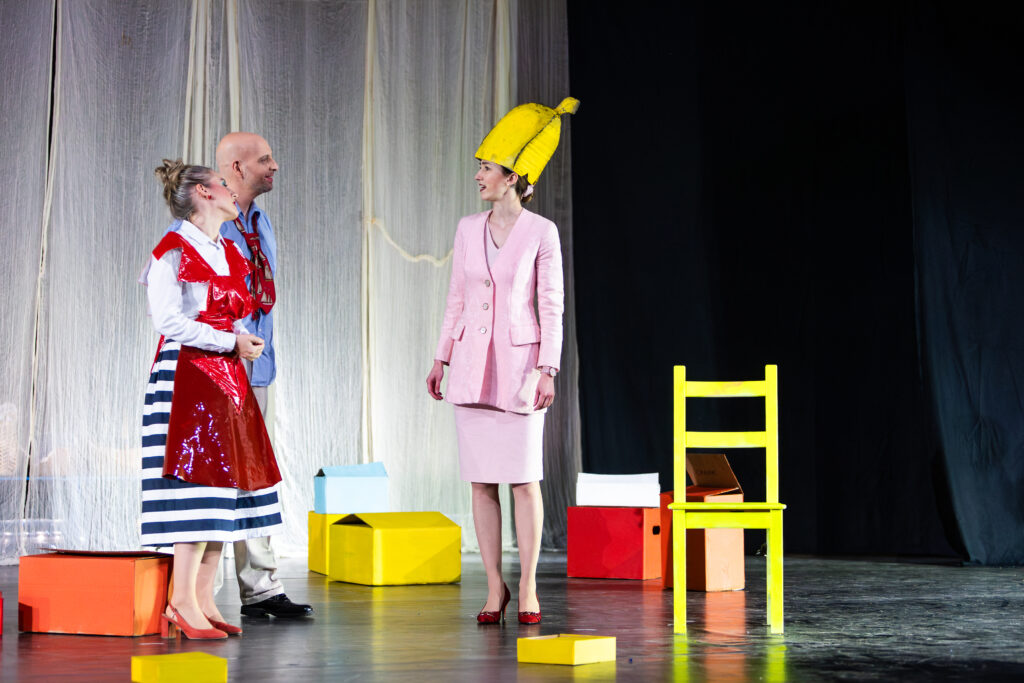By Alexandra Kaiser
What do a 1916 farmhouse murder mystery and a satirical portrait of a “perfect” American family from 1961 have in common? Both plays in Specters, a double bill of Susan Glaspell’s Trifles and Edward Albee’s The American Dream, explore the lasting effects of societal expectations and power imbalances, offering sharp critiques of their times while drawing unsettling parallels to the present.
Trifles is set in a lonely farmhouse where the murder of Mr. Wright has just been discovered. As the male officers dismiss small domestic details as unimportant “trifles”, Mrs. Peters and Mrs. Hale piece together the story of Mrs. Wright’s isolation and emotional suffering. They discover a broken birdcage and a strangled canary, leading them to realize that abuse drove Mrs. Wright to kill her husband, a discovery they choose to keep from the men.

In The American Dream, a dysfunctional family—Mommy, Daddy, and Grandma—awaits a visit from Mrs. Barker, who helped them adopt a son years ago. As secrets unravel, it’s revealed that the son failed to meet their expectations and was mutilated and discarded. In the end, they replace him with a “perfect” boy—emotionally hollow but physically flawless highlighting the emptiness of the pursuit of perfection. The play ends with a surreal twist: Daddy becomes Grandma, and the “perfect“ boy becomes Daddy, showing the endless cycle of societal ideals.
Both plays use powerful theatrical techniques to reinforce their themes. In Trifles, flashbacks of Mr. and Mrs. Wright’s relationship are projected on the wall, giving the play a ghostly feeling. This, coupled with the faceless creature representing abuse and suffering, makes the hidden horrors of the story impossible to ignore. At the end, the inclusion of real-world statistics about violence against women, along with the chilling line, “While you were watching this play, five women have been killed“ left a lasting impact.

The American Dream uses dark humor and exaggerated characters to critique consumerism and family disconnection. Mommy’s dominance over Daddy, Grandma’s fear of being discarded, and the introduction of the “perfect” boy all point to a world where appearances and success matter more than genuine human connection. The flashing TV images throughout the play emphasize the influence of media and the pressure of superficial ideals in modern life.
The performances in both plays were fantastic. In Trifles, the actresses playing Mrs. Hale and Mrs. Peters brought depth to their role, capturing the quiet strength and suppressed anger of their characters. The men were easy to dislike because they ignored the women’s comments, but they were also unique and interesting characters. The women’s performances were outstanding. I loved watching their slow journey toward awareness, and one actress’s cry near the end was truly powerful. Mrs. Peters and Mrs. Hale are two very different women. One is quiet and feminine, which is shown through her bulky dress that highlights her figure. The other is more confident and sterner, wearing a more masculine outfit, though still with a type of corset. These costume designs reflect different forms of femininity, contrasting with the men’s straight, masculine outfits. I appreciate how these character and costume designs subtly enhance the performance.
It was fascinating to see how different these women were, yet how similar their views were on life and the evidence they uncovered. The faceless creature was especially haunting, making the themes of domestic violence and abuse feel immediate and terrifying.

In The American Dream, the actors leaned into the absurdity of their roles. The actress playing Mommy was both hilarious and unsettling, while the actor portraying the “perfect” boy nailed his emotionless demeanor. Despite the 50 years separating the two plays—and the additional 60 years between The American Dream and today—many of the issues remain familiar. Trifles speaks to the silent suffering of women and how their experiences are often ignored, a theme that resonates with the current #tradwife movement. Like the women in the play, these modern housewives live within an idealized domestic role, presenting a curated, sometimes misleading image of their lives on social media.
Meanwhile, The American Dream critiques a society obsessed with superficial perfection. The image of the “perfect“ boy – emotionless and disconnected – feels strangely similar to today’s world of social media filters and the pressure to appear flawless. The idea of striving for perfection, whether in appearance or family life, still dominates modern culture.

The title Specters perfectly captures the ghostly themes in both plays—whether it’s the haunting presence of domestic abuse or the emptiness behind the “perfect” family. Specters is a powerful double bill that will leave audiences reflecting on how far society has – or hasn’t—come. It’s a must-see for anyone interested in feminist and social critiques, or for those who enjoy theater that challenges societal norms. Both plays offer chilling insights into the ghosts of societal expectations, making them as relevant today as when they were first written.

Photos by Sarah Naumann


Schreibe einen Kommentar